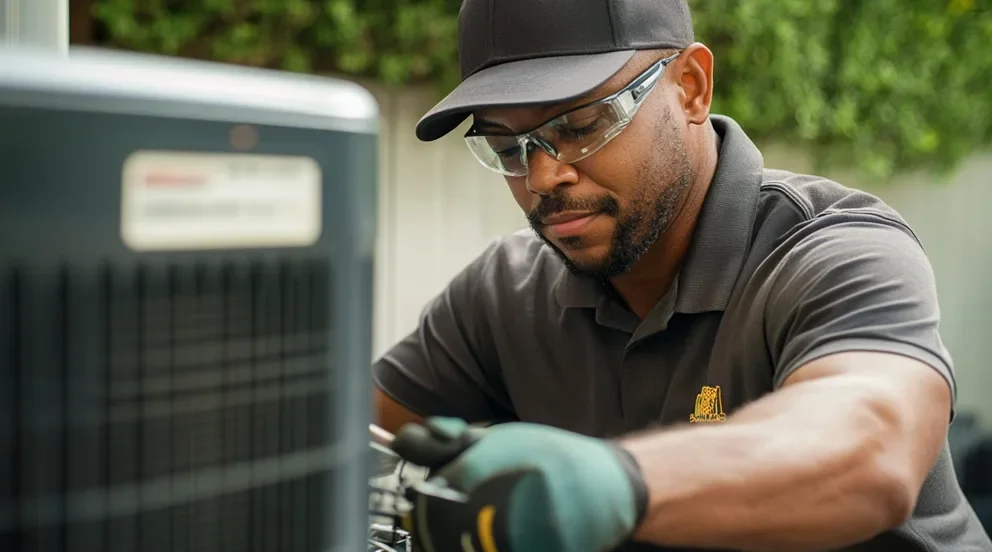A Home HVAC Monitoring System is a sophisticated technology specifically designed to track, regulate, and optimize the operation of heating, ventilation, and air conditioning units within a residence. This system serves as the central hub of a home’s climate control infrastructure, offering homeowners the ability to monitor environmental conditions and make adjustments remotely. The system’s sensors and software components work together to provide real-time data on temperature, humidity, and air quality.
Integrating with smart home platforms, a Home HVAC Monitoring System can automate climate control, reacting adaptively to changes in the environment or to preset user preferences. This not only enhances the comfort of the living space but can also lead to significant energy savings. Moreover, such systems often include maintenance reminders and diagnostics, alerting homeowners to potential issues before they escalate into costly repairs.
The implementation of a Home HVAC Monitoring System is an investment in home efficiency and personal comfort. It stands out as a pivotal component in modern smart homes, focusing on convenience and conservation. As sustainability becomes increasingly important, these systems represent a step towards more eco-friendly living, reducing the carbon footprint associated with heating and cooling our homes.
Harnessing the power of innovation, the Home HVAC Monitoring System has redefined climate control, transforming how we manage comfort and energy usage in our homes. Through this article, we will embark on a journey to uncover the intricacies of this remarkable system. We will delve into its myriad of benefits, from enhanced comfort and convenience to improved energy efficiency and cost savings.
The modern homeowner stands at the cusp of a new era where technology seamlessly integrates into daily life. In this context, understanding the pivotal role that a Home HVAC Monitoring System plays is more crucial than ever. It not only dictates the quality of your indoor environment but also reflects upon contemporary issues such as energy conservation and the trend towards smart home automation.
As you continue reading, prepare to explore how the Home HVAC Monitoring System isn’t just a tool for maintaining optimal conditions within your abode. It’s a gateway to a future where the home adapts to you, learning from your preferences to create an atmosphere that’s not only comfortable but also conscientious of the broader implications for environmental stewardship.
Smart Home Evolution: How HVAC Monitoring Systems Are Ushering in a New Era of Energy Efficiency
Smart homes are rapidly evolving, and HVAC monitoring systems stand at the forefront of this revolution. These systems provide precise control over indoor climates, reducing energy waste significantly. By learning from homeowner habits, these systems optimize heating and cooling cycles, ensuring peak efficiency. Detailed analysis of temperature trends helps in identifying the best settings, making energy use more economical.
Advanced sensors play a crucial role, constantly measuring indoor air quality and temperature. They quickly adjust settings, maintaining optimal conditions without excessive energy consumption. Continuous monitoring also flags potential inefficiencies, allowing for prompt rectifications. In this way, HVAC systems are not constantly running, leading to quieter homes with lower utility bills.
Manufacturers are embedding smart technology into HVAC units, making integration seamless. These energy-efficient systems intelligently interface with other smart home devices. The result is an interconnected home where lighting, security, and HVAC systems work in unison for optimal energy use. This collaborative ecosystem is the backbone of future smart homes.
Consumer awareness regarding energy consumption is also driving the demand for smart HVAC systems. Homeowners are becoming more environmentally conscious, seeking out green solutions for their living spaces. HVAC monitoring systems represent a tangible step towards sustainable living, providing homeowners with both cost savings and peace of mind.
These monitoring systems are not just a passing trend; they signify a paradigm shift in home energy use. They are essential tools in combating climate change by reducing individual carbon footprints. As technology advances, the role of HVAC monitoring in energy efficiency will only grow, offering homeowners unparalleled control over their environment.
Get Ahead of the Game: Predictive Maintenance with Advanced HVAC Monitoring
Maintaining comfort in homes and buildings has traditionally been reactive, but predictive maintenance with advanced HVAC monitoring systems is changing the game. By preemptively identifying issues before they escalate, these systems save time and money. Regular wear and tear can be tracked, anticipating breakdowns before they cause discomfort or require expensive repairs.
The heart of predictive maintenance lies in real-time data analysis. Robust algorithms interpret signals from various sensors, predicting when components might fail. This data-driven approach can lead to significant cost savings, especially when it prevents the need for emergency services. Thus, instead of waiting for a malfunction, smart monitoring means being steps ahead in maintenance.
Predictive maintenance isn’t just about preserving hardware; it’s also about ensuring consistent comfort for occupants. Advanced monitoring systems can detect slight changes that may affect temperature and humidity, enabling adjustments without notice. A stable indoor environment is maintained, ensuring residents or workers are always at ease.
Moreover, advanced HVAC monitoring systems often come equipped with remote diagnostics capabilities. Technicians can assess the system’s health from afar, prescribing corrective actions without setting foot on-site. This minimizes interference with daily activities and maintains social distancing where necessary. Technology thus enables smoother operations and better service experiences.
Investments in predictive maintenance technologies offer long-term benefits. The insights provided by monitoring tools empower homeowners and facility managers to make smarter decisions about their HVAC systems. As systems grow more sophisticated, the ability to preemptively service and repair will become a hallmark of advanced property management.
Beyond Temperature Control: Innovative Features of Modern HVAC Monitoring Systems
Modern HVAC monitoring systems transcend basic temperature regulation, offering a suite of innovative features designed to create an intelligent living space. These systems facilitate zonal control, where different areas of a property can be heated or cooled independently. This level of precision ensures comfort without squandering energy on unused rooms, harnessing technology for smarter living.
Another advanced feature is the integration with weather forecasts. HVAC systems can adjust preemptively to sudden changes in weather, maintaining indoor comfort no matter the conditions outside. Intelligent anticipation of environmental shifts is a hallmark of modern life, where technology stays a step ahead of nature’s unpredictability.
Voice-activated controls and app interfaces are modern conveniences that enhance user interaction with HVAC systems. Users can now command their HVAC units with simple voice prompts or touch of a screen, whether at home or remotely. Automation has never been more accessible, fitting seamlessly into the daily routine of tech-savvy homeowners.
Wear and tear on HVAC systems are unavoidable, but modern monitoring tools can significantly extend their lifespan. Through detailed analytics, these systems signal when parts are under duress, helping to preserve the overall health of the machinery. This foresight not only aids in maintenance but also ensures the longevity of the HVAC system as a whole.
Being interconnected with other smart home systems, modern HVAC units harmonize with security, lighting, and more. This integration optimizes energy usage across the board, creating a synergistic effect for all connected devices. It’s a prime example of how technology is evolving to not just serve our immediate needs but to enhance overall home intelligence and efficiency.
HVAC Monitoring and the Environment: Reducing Your Carbon Footprint
The connection between HVAC monitoring and environmental impact is crystal clear. By using technology to manage heating and cooling systems more efficiently, one can significantly reduce their carbon footprint. Reducing energy usage not only lowers utility bills but also lessens the reliance on fossil fuels, a step towards a more sustainable future.
Monitoring systems aid in achieving eco-friendly ambitions by offering detailed energy consumption reports. These reports highlight how and when energy is used most, empowering homeowners to adjust usage patterns. Informed decisions can then be made that balance comfort with conservation principles, effectively contributing to larger environmental goals.
Additionally, proper maintenance of HVAC systems, prompted by advanced monitoring, ensures they run at peak efficiency. Efficient systems consume less energy and generate fewer greenhouse gases, all while preserving the comforts of a controlled indoor environment. This dual benefit underscores the role of HVAC monitoring in ecological stewardship.
For residential areas, the widespread adoption of HVAC monitoring could have profound effects on the environment. If mass implementation occurs, the cumulative savings in energy and emissions would be substantial. This potential hints at an environmentally friendly shift in how communities manage their shared carbon output.
Even the production of HVAC systems is being scrutinized for environmental impact. Developers focus on creating devices that are not only smart but also made from sustainable materials. The goal is for the very existence of HVAC systems, from cradle to grave, to embody the ethos of environmental consciousness and responsibility. In this way, HVAC monitoring can be seen as a critical facet of a holistic approach to mitigating climate change.



